Coloured Diamonds, or so called Fancy colour diamonds, are diamonds that have naturally formed in shades of pink, green, blue, yellow and even red, amongst other colours. They are appraised by a set of nine different categories in a colour grading chart. Ranging from Faintly Coloured (the weak presence of a colour), to Fancy Vivid Colour (the very pronounced presence of a colour). The important characteristics of coloured diamonds are the scale of Hue (intensity of Colour), Tone (Brightness or shade) and Saturation (concentration of colour).
Click below for more detailed information about individual colours.
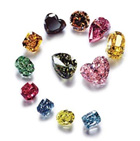
- Pink Diamond
- Brown Diamond
- Blue Diamond
- Green Diamond
- Yellow Diamond
- Red Diamond
- Orange Diamond
- Black Diamond
Fancy coloured diamonds are still among nature’s scarcest phenomenon, and rarity commands their very high commercial value. For instance it has been estimated that for every 10,000 colourless diamonds one coloured diamond is mined. More importantly, a diamond’s chances of exhibiting intense colour are even less, reportedly one in 25,000 diamonds. The highest price ever paid per carat for a Fancy coloured diamond was $926.315 for a 0.95 carat fancy Purplish Red stone sold at Christies Auction House in 1987.
Fancy Coloured Diamonds have seen a resurgence amongst consumers as they have become more fashionable. However the price tag has made it virtually impossible for ordinary consumers to buy. As a result it has become easier to own a coloured diamond that has been achieved through high heat treatments and irradiation, thus transforming plainer diamonds into fancy coloured diamonds. Irradiated diamonds are much more affordable than natural fancy coloured diamonds and just as magnificent.
Pink Diamond
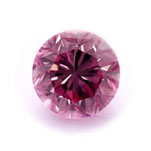 The most precious of natural fancy coloured diamonds are the Pink Diamonds. The scarcity of the stone makes it one of the most high-priced and sought after diamonds. Natural Pink Diamonds vary in hue from dark red-bluish pink to intense orangey pink. The cause of the colour variation is believed to be a result of the stone’s thermo-nuclear composition. Pink diamonds are graded according to the concentration of pink colour in each single stone. The scale cascades from 1 to 8, one being the most intense colour and eight the lightest colour. That grading is then given a further categorisation according to each separate diamond hue. For example: PP – Purplish Pink, P – Pink, BP – Brownish Pink, PC – Pink Champagne. The intensity of Pink Diamonds are as follows: Very intense, Intense, Strong, Medium, Medium Light, Light, Very Light and Blush.
The most precious of natural fancy coloured diamonds are the Pink Diamonds. The scarcity of the stone makes it one of the most high-priced and sought after diamonds. Natural Pink Diamonds vary in hue from dark red-bluish pink to intense orangey pink. The cause of the colour variation is believed to be a result of the stone’s thermo-nuclear composition. Pink diamonds are graded according to the concentration of pink colour in each single stone. The scale cascades from 1 to 8, one being the most intense colour and eight the lightest colour. That grading is then given a further categorisation according to each separate diamond hue. For example: PP – Purplish Pink, P – Pink, BP – Brownish Pink, PC – Pink Champagne. The intensity of Pink Diamonds are as follows: Very intense, Intense, Strong, Medium, Medium Light, Light, Very Light and Blush.
Pink diamonds were first mined in India around 14th century. Later on small quantities were found in Latin America and South Africa, but the colour was subtle and with little saturation. In 1979, however, the Argyle diamond mine was discovered in Western Australia. Since then the mine production has peaked substantially to supply around 95 per cent of all pink diamonds on the market. The natural fancy pinks produced in the Argyle mines are more saturated than those found in the past and are in abundance compared to the rest of mines in other regions.
The growth in supply and accessibility of the pink diamond, together with their popularity amongst famous people, has propelled an upsurge in the demand and price of the pink diamond. The Steinmetz Pink is a diamond weighing 59.60 carats (11.92 g), rated in colour as Fancy Vivid Pink by the Gemmological Institute of America. The Steinmetz Pink is the largest known diamond that has been rated Vivid Pink. It is Oval Brilliant, with an estimated value of 25 million dollars.
Brown Diamond (Champagne or Cognac diamonds)
 Brown coloured diamonds fluctuate in their saturation and hue. The lack of popularity amongst consumers has made the brown diamonds traditionally less expensive than other coloured diamonds. However, there has been resurgence in their appeal in recent times when they were branded and marketed as “cognac” or “champagne” coloured diamond, appealing to diamond buyers. The Argyle diamond mine in Australia is the most prominent producer of brown diamonds in the world.
Brown coloured diamonds fluctuate in their saturation and hue. The lack of popularity amongst consumers has made the brown diamonds traditionally less expensive than other coloured diamonds. However, there has been resurgence in their appeal in recent times when they were branded and marketed as “cognac” or “champagne” coloured diamond, appealing to diamond buyers. The Argyle diamond mine in Australia is the most prominent producer of brown diamonds in the world.
Brown Diamonds categorised as champagne / Cognac diamonds are rated from C1 to C7.
The colour grading of the brown diamonds are as follows: C1 and C2 diamonds are considered subtle champagne, C3 and C4 moderate champagne, and C5 and C6 deep champagne. Diamonds with C7 colour grading are considered Cognac coloured, as they display the most intense, rich brown colour. The Cognac coloured Diamonds exhibits a dark orange-brown colour, diamonds ranked as cognac coloured commands a higher price tag.
One of the most famous brown diamonds is the Great Chrysanthemum diamond. It originated in South Africa weighing 198.28 carats. It has been cut into a pear shape, weighing 104.15 carats with 189 facets.
Blue Diamond
 Blue diamonds were mined earlier on in many parts of the world, including India, Brazil and Indonesia. Currently, mainly Australia and the Cullinan and Premier Diamond mines in South Africa produce the blue colour diamonds. They are one of the most rare and precious of all the coloured diamonds. A blue diamond can cost as much as $100,000 to $250,000 per carat, depending on clarity, colour, and size.
Blue diamonds were mined earlier on in many parts of the world, including India, Brazil and Indonesia. Currently, mainly Australia and the Cullinan and Premier Diamond mines in South Africa produce the blue colour diamonds. They are one of the most rare and precious of all the coloured diamonds. A blue diamond can cost as much as $100,000 to $250,000 per carat, depending on clarity, colour, and size.
The most famous blue diamond is the “Hope diamond “, with a reputation for bringing bad fortune to its owner. Originating in India, its weight is reported to be 45.52 Carat and is classified as intense blue diamond. It currently resides in the Smithsonian Institute. It is cut in the cushion shape. The current estimate of its market value is over 215 million dollars. The Hope diamond gets its name from Henry Philip Hope.
A presence of the mineral Boron in the diamond is what gives the natural blue diamond its colour. The Blue diamond colour chart cascades from pale sky blue to a vivid peacock blue. Colour depth, from the greatest colour concentration to the least, is graded as Vivid, Intense, Fancy or Light. Most natural blue diamonds are a very light blue.
Vivid, deep blue diamonds are considered the most sought after. It is, however, the combination of colour, cut, clarity and carat weight which gives any stone its value.
Green Diamond
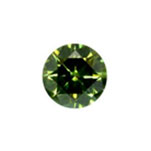 The vivid green coloration/ hue in a diamond is caused by direct contact with a radioactive rays at some point during its lifespan. The time required for the coloration process may be in the vicinity of a million years. Green diamonds of this quality are very rare.
The vivid green coloration/ hue in a diamond is caused by direct contact with a radioactive rays at some point during its lifespan. The time required for the coloration process may be in the vicinity of a million years. Green diamonds of this quality are very rare.
The largest natural green diamond in the world is The Dresden Green. It is classified as an “apple-green” colour and weighs in at 40.70 carats. Reportedly it is considered the finest natural green diamond ever found. The Dresden Green gets its name from the capitol of Saxony where it has been on exhibition for more than 200 years.
Yellow Diamond
 One of the most common colours found in diamonds is yellow. Yellow diamonds range from very pale yellow to vivid fancy yellow, depending on the amount of nitrogen atoms attracted in the course of the crystallization phase.
One of the most common colours found in diamonds is yellow. Yellow diamonds range from very pale yellow to vivid fancy yellow, depending on the amount of nitrogen atoms attracted in the course of the crystallization phase.
Vivid fancy yellow diamonds are rare and relatively high-priced, as in the case of all fancy coloured diamond. The “Tiffany” Diamond is the largest known yellow diamond. Discovered in South Africa, it initially weighed 280 carats but after cutting, it currently weighs 128 carat.
Fancy yellow diamonds, based on their intensity of colour are graded in a five colour scale: starting from, the palest yellow, fancy light yellow, fancy yellow, fancy intense yellow and fancy vivid yellow. About 20 per cent of the world’s biggest and most well-known diamonds are yellow, but few of them are fancy vivid yellow.
Because of the scarcity of vivid yellow stones, colour irradiation treatments are regularly performed to satisfy consumer demands. Irradiated yellow diamonds are inexpensive compared to natural fancy diamonds and are in abundance on the market.
The majority of yellow diamonds are faint or light yellow. These type of diamonds are inexpensive and are experiencing a huge demand amongst consumers, because of their overall ability to assimilate attractively with white diamonds and white gold jewellery.
Red Diamond
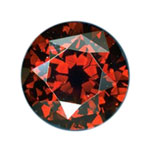 The distinct absence of a colour in a diamond is what makes it precious, as any coloration results in reduced price. However this isn’t the case in rare fancy vivid coloured diamonds, especially the Red diamond. It is considered to be the rarest diamond mined thus far. Interestingly enough, the number of red diamonds existing in the world is not known. Some estimates are in the vicinity of 50 only. Red diamonds develop their colour when nitrogen and pressure creates the vivid colour deep beneath earth’s crust.
The distinct absence of a colour in a diamond is what makes it precious, as any coloration results in reduced price. However this isn’t the case in rare fancy vivid coloured diamonds, especially the Red diamond. It is considered to be the rarest diamond mined thus far. Interestingly enough, the number of red diamonds existing in the world is not known. Some estimates are in the vicinity of 50 only. Red diamonds develop their colour when nitrogen and pressure creates the vivid colour deep beneath earth’s crust.
One of few famous red diamonds is the 1 Carat Halphen Diamond. Presently, there are two other known red diamonds known to public, and both are valued over 1 million dollars. They are the 5.1 carat Moussaieff Red, and the .95 Carat Hanckock diamond.
The Argyle mine in Western Australia produces a very small quantity of red diamonds with the best ones auctioned off each year.
The Orange Diamond
 The orange coloured diamond is regarded to be one of the most beautiful fancy colour diamonds. The presence of nitrogen and carbon lattice is the reason for its stunning colour. It has the hue of the scarce Red diamond and the lustre of the Yellow diamond, so when viewing with a naked eye it looks orange. The second tier hues, such as red, orange and yellow colours, combine to exhibit diverse variations of colour depending on the depth of the hues.
The orange coloured diamond is regarded to be one of the most beautiful fancy colour diamonds. The presence of nitrogen and carbon lattice is the reason for its stunning colour. It has the hue of the scarce Red diamond and the lustre of the Yellow diamond, so when viewing with a naked eye it looks orange. The second tier hues, such as red, orange and yellow colours, combine to exhibit diverse variations of colour depending on the depth of the hues.
Orange diamonds are occasionally irradiated to extort from them even more vivid colour. The diamond grading can be either faint, very light, light, fancy, fancy intense, fancy vivid, and fancy deep. The most Famous orange diamond is on exhibition in museums around the world. It is called the “Pumpkin” and was worn by Halle Berry at the 2002 Oscar awards. It is an intense vivid orange colour, and weighs 5.54 carats. The Pumpkin is considered to be the largest fancy orange diamond ever mined.
Black Diamond
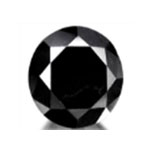 Black diamonds have a composition quite different to other diamonds. Unlike other diamonds, which are composed of a single crystal, Black diamonds are made up of thousands minute crystals fused together. The abundance of the inclusions and the existence of tiny sulphides are the main cause for the dark colour. Black diamonds are not totally black as widely believed. They tend to contain shades of grey to dark grey appearance. The colour, however, varies significantly based on the amount of imperfections and sulphides in the diamond.
Black diamonds have a composition quite different to other diamonds. Unlike other diamonds, which are composed of a single crystal, Black diamonds are made up of thousands minute crystals fused together. The abundance of the inclusions and the existence of tiny sulphides are the main cause for the dark colour. Black diamonds are not totally black as widely believed. They tend to contain shades of grey to dark grey appearance. The colour, however, varies significantly based on the amount of imperfections and sulphides in the diamond.
Amongst many famous Black Diamonds, one stands out – the “Black Orlov”. Also known as “the Eye Of Brahma”, it weighs in at 67.5 Carats. There is a myth surrounding this famous diamond. According to legend, it has brought the demise of its owners. Other famous black diamonds include the Amsterdam Diamond (55.85 carats), the Black Star of Africa (202 carats), and the Black Diamond of Bahia (350 carats).
Similar to conventional diamonds, it is important for black diamonds to be cut into the proper proportions, as this will maximise their vividness, lustre and most importantly, their rich black colour.
Through concentrated marketing, the black diamond has seen a resurgence in interest amongst consumers. Its black colour coupled with the perfect brilliant cut, makes it a stunning contrast in white gold jewellery, accompanied with small diamonds.